Wayne Gillam
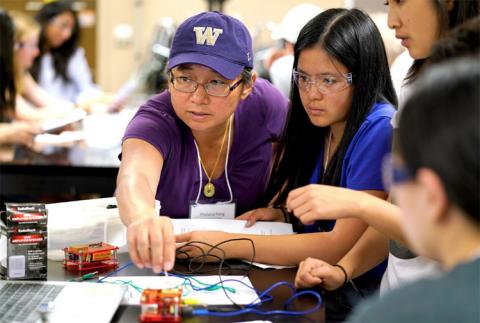
The Research Experience for Teachers (RET) program is supporting middle and high school teachers who return to the Center for Neurotechnology (CNT) year-after-year, benefiting not only those teachers’ students and peer educators, but the CNT’s education programs and researchers as well.
Phelana Pang, a middle school science teacher at the Seattle Girls’ School, first discovered the Center for Neurotechnology (CNT) in 2015 while she was searching for science-related field trips her students would enjoy. After deciding to visit the CNT, she learned about the center’s Research Experience for Teachers (RET), a summer program that gives middle and high school science teachers a hands-on research experience in service of creating and developing neural engineering lesson plans for their students. Pang participated in the 2016 RET program, and thereafter, she was hooked.

“I love being at the center. I can’t stay away. It’s a great place to learn about what’s possible in the field of neuroengineering for students, teachers and the general public,” Pang said. “I loved making connections with university faculty members and collaborating with other [K-12] teachers too. Collaborating is big for me as an educator who’s always learning. I’ve benefited so much from being a part of the CNT and my students have as well. From the research, curriculum development, visits to labs, and teaching about neuroscience and engineering, I’ve grown a lot professionally and have been able to provide more windows into opportunities for my students through my university connections.”
When a teacher comes back to the center for more than one year, we can build our relationship with them over time. We’re helping them deepen their interest in the topic [neurotechnology] and to develop strategies for how they’re going to teach it.
– CNT Engineering Education Research Manager, Kristen Bergsman
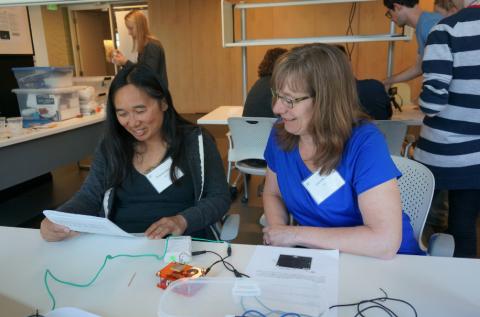
Pang enjoyed her experience so much that after piloting the curriculum she developed through the RET program for her students, she returned to the program in 2017 for a second year. In 2018, she returned to the center again, this time to teach and help facilitate classes in the Young Scholars Program (YSP)-REACH, which gives high school students an introduction to neuroscience, neural engineering and the latest developments in brain-computer interfaces.
“Phelana is very knowledgeable about the CNT, because she’s participated in two years of the RET program,” said CNT Precollege Education Manager, Janis Wignall. “She became a valuable source of knowledge within the YSP-REACH program, teaching curriculum she developed at the CNT about constructing sensory substitution devices using Arduino microprocessors and coaching students to have a successful experience.”
Pang’s involvement with the CNT over the last four years had multiple touchpoints. In addition to bringing her students on field trips to visit the center, assisting with research and developing neural engineering lesson plans through the RET program, Pang presented the curriculum she developed to peer educators at the 2018 American Society of Engineering Education (ASEE) conference. Pang and fellow returning RET program participant, Laura Moore, also presented curriculum units they designed at the CNT to attendees of the 2018 Northwest Council for Computer Education (NCCE) conference.
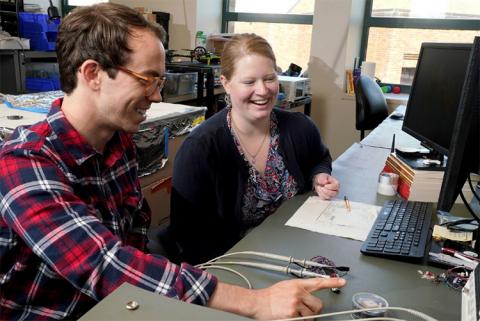
The multi-year involvement of Pang, Moore and other former RET participants and the unique benefits they bring to the center have not gone unnoticed. This October, CNT Engineering Education Research Manager, Kristen Bergsman, will be attending the first “NSF [National Science Foundation] Research Experience for Teachers: Leveraging our Collective Impact Conference.” There, she’ll share with other attendees a six-year study of the RET program’s impact that she co-authored and presented last June at the ASEE conference, as well as her observations about the benefits of engaging and supporting teachers like Pang and Moore for multiple years.
“One of our goals for the RET program is to support teachers in bringing the topic of neurotechnology into their K-12 classrooms. When a teacher comes back to the center for more than one year, we can build our relationship with them over time. We’re helping them deepen their interest in the topic and to develop strategies for how they’re going to teach it,” said Bergsman. “We’re also supporting them in writing papers, developing [scientific] posters and making presentations at conferences, which benefits their own professional learning while broadly disseminating their curriculum materials to other science educators. They become experts who have the confidence to share their new knowledge with peers.”
The two-way benefits of teachers’ research experience
The motivations for teachers to return to the RET program and the CNT can vary depending on the individual. For Alexandra Pike, a science teacher at Juanita High School in Kirkland, Washington who participated in the RET program with Pang in 2016 and 2017, it was a love of research that brought her back to the CNT for a third summer in 2018.
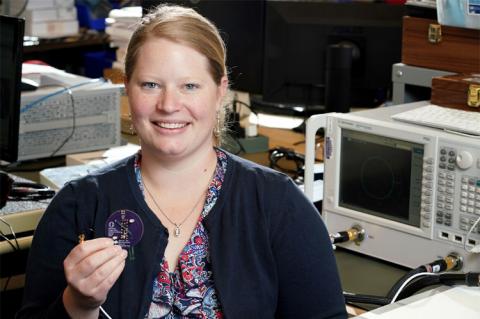
Pike spent her first two summers in the RET program working in the lab of CNT member, Matt Reynolds. Using her research experiences as a framework, she designed lesson plans for her science students and then later presented her curriculum to peer educators at the 2018 ASEE conference. In the summer of 2018, she returned to Reynolds’ lab again, focusing more on the research experience this time and less on curriculum development. In the lab, Pike worked on testing experimental antennas designed to transmit power and data to an implantable wireless communication chip. This research was aimed at reducing the need for invasive surgeries to replace batteries in neural devices and other medical implants, such as pacemakers.
“I enjoyed being able to be a part of the engineering research world and just getting excited about learning so many new things again,” Pike said. “I was able to link what I learned back to what I teach my students too. Not directly in terms of content this time, but just by being able to use more of the engineering language authentically and with confidence.”
She [RET program participant, Alexandra Pike] brings a great skill set that you develop as a high school teacher into this experience, excellent organizational skills and really great planning. It’s been a huge help, really. We’ve been able to knock-out some really important tests this summer, and a lot of that is thanks to her help.
– UWECE graduate student and RET program mentor, James Rosenthal
The benefits were two-way. Pike is now co-authoring a paper with the lab members, which speaks to her value as a part of the research team, and it is a first for the RET program. Her mentor in the lab, University of Washington Electrical & Computer Engineering graduate student, James Rosenthal, described how helpful it was to have Pike as a research assistant.
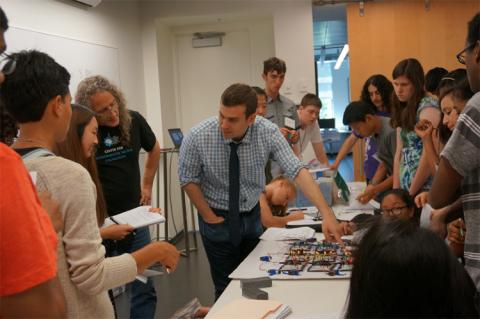
“It’s been overall a great experience. She’s extremely helpful and definitely brings in a different perspective coming in from the teaching side, especially working with high school students. Working in a lab, you can be somewhat insulated, since you work with the same people every day on the same topics, talking about the same things,” Rosenthal explained. “Personally, I found it very beneficial in terms of learning how to communicate our work, because having to integrate a new member of the team who doesn’t have the same background you have encourages you to learn how to describe things differently, describe advanced technologies in terms that you’re not used to using that are more understandable for the general public. Also, she brings a great skill set that you develop as a high school teacher into this experience, excellent organizational skills and really great planning. It’s been a huge help, really. We’ve been able to knock-out some really important tests this summer, and a lot of that is thanks to her help.”
Impacts on precollege education
Pang and Pike are representative of a small, but growing, group of teachers returning to the CNT after their first round in the RET program. For example, high school science teachers, Larry Bencivengo and Benjamin Hart have also remained actively connected with the CNT since 2015. In addition to continuing to teach their students the Building Artificial Neural Networks curriculum they co-designed in the RET program, both returned to the center last year to teach and help facilitate CNT summer program classes. They also led sessions focused on their artificial neural network curriculum both regionally and nationally at the 2017 Washington Science Teacher Association (WSTA) conference in Pasco, Washington and the 2017 National Science Teachers Association (NSTA) conference in Atlanta, Georgia.
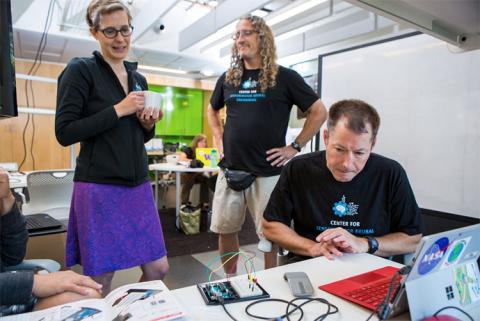
“The RET experience with the CNT was a fun challenge. I grew both personally and professionally by gaining experience in a research lab, being out of my comfort zone for a few months in a stimulating environment, remembering what it is like to be a student again—being the one asking the questions instead of the one providing the answers—and I met some truly amazing people, both in the lab and the other teachers in my cohort,” Bencivengo said. “The RET program led me fairly directly to applying for a Murdock Grant and continuing the experience of interning in a research lab for two more years. The partnership that Benjamin and I developed that summer has helped me to transition into a new phase in my career, giving me the confidence to share what I have been doing in my classroom with other teachers by presenting at WSTA and NSTA.”
The teachers that return year-after-year are very valuable to us. What we’re seeing now is they’ve grown more confident, they’re using the curricula in their classrooms, and now they’re publishing papers and going to meetings.
– CNT Precollege Education Manager, Janis Wignall
The multiplicative effect of returning teachers like Pang, Pike, Bencivengo and Hart repeatedly sharing their knowledge and experience in the research lab, with their students and with other teachers on local, regional and national levels has had a dual impact of enriching the CNT’s unique innovation ecosystem while expanding the reach of precollege neural engineering education into classrooms across the country.
“The teachers that return year-after-year are very valuable to us. What we’re seeing now is they’ve grown more confident, they’re using the curricula in their classrooms, and now they’re publishing papers and going to meetings,” Wignall said. “That’s a really effective way to see that your teachers are proficient, want to represent the work and teach it at conferences and have an even bigger impact. It’s a powerful indicator of the kind of RET program that we have developed at the CNT.”
